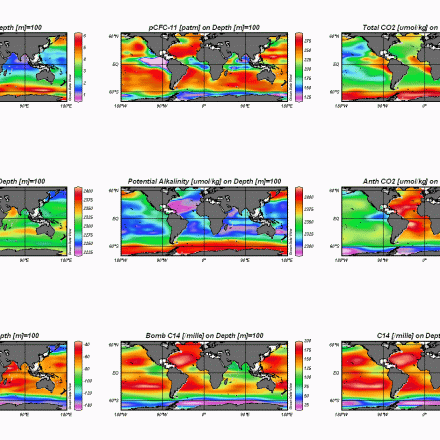GLODAP: GLobal Ocean Data Analysis Project for Carbon

The GLobal Ocean Data Analysis Project (GLODAP) is a cooperative effort to coordinate global synthesis projects funded through the National Oceanic and Atmospheric Administration (NOAA), the U.S. Department of Energy (DOE), and the National Science Foundation (NSF) as part of the Joint Global Ocean Flux Study - Synthesis and Modeling Project (JGOFS-SMP).
Cruises conducted as part of the World Ocean Circulation Experiment (WOCE), JGOFS, and the NOAA Ocean-Atmosphere Exchange Study (OACES) over the decade of the 1990s have created an oceanographic database of unparalleled quality and quantity. These data provide an important asset to the scientific community investigating carbon cycling in the oceans.
The central objective of this project is to generate a unified data set to help determine the global distributions of both natural and anthropogenic inorganic carbon, including radiocarbon. These estimates provide an important benchmark against which future observational studies will be compared. They also provide tools for the direct evaluation of numerical ocean carbon models.
Key Limitations
Cite this page
Acknowledgement of any material taken from or knowledge gained from this page is appreciated:
National Center for Atmospheric Research Staff (Eds). Last modified "The Climate Data Guide: GLODAP: GLobal Ocean Data Analysis Project for Carbon.” Retrieved from https://climatedataguide.ucar.edu/climate-data/glodap-global-ocean-data-analysis-project-carbon on 2025-12-25.
Citation of datasets is separate and should be done according to the data providers' instructions. If known to us, data citation instructions are given in the Data Access section, above.
Acknowledgement of the Climate Data Guide project is also appreciated:
Schneider, D. P., C. Deser, J. Fasullo, and K. E. Trenberth, 2013: Climate Data Guide Spurs Discovery and Understanding. Eos Trans. AGU, 94, 121–122, https://doi.org/10.1002/2013eo130001
Key Figures

GLODAP survey map (source: http://cdiac.ornl.gov/oceans/glodap/Glopresult.html)

Sample gridded surface GLODAP fields at 100m(source: http://cdiac.ornl.gov/oceans/glodap/Glop_grid_OV.html)
Other Information
- Sabine, C,L, et al (2004): The Oceanic Sink for Anthropogenic CO2 . Science 305, 5682:367–71
- Keeling, R.F. (2005): Comment on "The Oceanic Sink for Anthropogenic CO2"
- Sabine, C,L and N. Gruber (2005): Response to Comment on "The Ocean Sink for Anthropogenic CO2"
- Dickson, A.G. et al (Eds.) 2007. Guide to best practices for ocean CO2 measurements. PICES Special Publication 3, 191 pp.
- Key, R.M. at al (2004), A global ocean carbon climatology: Results from Global Data Analysis Project (GLODAP), Global Biogeochem. Cycles , 18 , GB4031
- Willey, D.A. et al (2004): Global oceanic chlorofluorocarbon inventory. Geophysical Research Letters, VOL. 31, L01303.